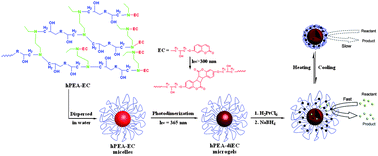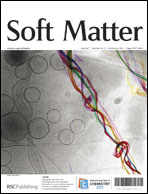We report novel multistimuli responsive microgels based on coumarin-containing hyperbranched poly(ether amine) (hPEA-EC). hPEA-EC could be dispersed directly in aqueous solution as polymer particles, whose cores were crosslinked through the photodimerization of coumarin moieties to form microgels with size of about 150 nm in diameter. The obtained microgels (hPEA-diEC) exhibited good stability in aqueous solution and possessed sharp response to temperature, pH and ionic strength with tunable cloud point (CP). Simultaneously, hPEA-diEC microgels decorated with platinum nanoparticles (Pt@hPEA-diEC) were investigated as microreactors for reduction of aromatic nitro compounds. Pt@hPEA-diEC exhibited interesting catalytic activities for the reduction of nitrophenol, which is obviously faster at lower temperature. Compared with the reduction of 4-nitrophenol (Nip), Pt@hPEA-diEC is more efficient in catalytic activity for reduction of the hydrophobic 4-nitro-3-(trifluoromethyl)phenol (CF3Nip), which is probably ascribed to the encapsulation of CF3Nip in hPEA-diEC microgels. These characteristics give hPEA-diEC microgels potential as intelligent materials for the controlled reduction of nitro compounds in water.

You have access to this article
 Please wait while we load your content...
Something went wrong. Try again?
Please wait while we load your content...
Something went wrong. Try again?


 Please wait while we load your content...
Please wait while we load your content...